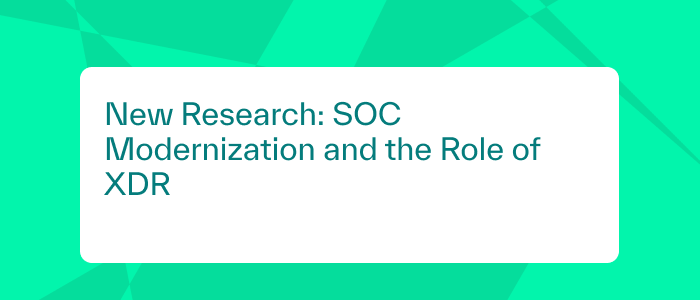
Security operations demand massive scale to collect, process, analyze, and act upon massive amounts of data. Early XDR was anchored to two primary data sources: endpoints and networks. While this improved disconnected EDR and NDR tools, threat detection and response across enterprise organizations demands a broader aperture, including cloud workloads, threat intelligence feeds, SaaS applications, and identity and access management visibility. At the same time, to modernize security operations centers and keep up with the volume of security alerts, large organizations need advanced analytics to help automate tier-1 analyst tasks like triaging alerts, correlating alerts with IoCs, and preparing incidents for investigations. What is the role of XDR in the modern Security Operations Center (SOC)?
To gain insights into these trends, Enterprise Strategy Group (ESG) surveyed 376 IT and cybersecurity professionals in North America who were personally responsible for evaluating, purchasing, and utilizing threat detection and response security products and services. The results of this research are available in an eBook, “SOC Modernization and the Role of XDR,” authored by Jon Oltsik, Senior Principal Analyst & ESG Fellow, and Dave Gruber, Principal Analyst.
This informative eBook is based on ESG’s comprehensive SOC survey and focuses on the following:
According to a Gartner report, “By 2025, 50% of organizations will be using XDR as their primary SOC platform for security alert analysis and incident response, up from less than 5% in 2020.”
This statistic highlights XDR’s growing adoption and importance (Extended Detection and Response) in modernizing security operations centers (SOCs). The significant increase in XDR usage as the primary SOC platform indicates that organizations recognize its value in enhancing SOC’s threat detection, investigation, and response capabilities.
Gurucul Open XDR provides the visibility, context and options to identify attacks to analysts of any experience level. It’s engineered for ultimate flexibility and interoperability across existing technology, so you’re never locked into an endpoint provider or settling for detection coverage gaps or silos.
Our intelligent data fabric seamlessly ingests data from any source, filters unnecessary data to low-cost storage, enriches data for advanced analytics and searches any storage without rehydration. Gurucul can be rolled out in days and is easy to implement, providing value right out of the box with a library of 3,000 pre-tuned ML models and integrating seamlessly with your existing SOAR platform using simple APIs. The user-friendly GUI tool enables automated case management as well as custom ML model development without requiring data scientists. Its open data model saves money and provides a higher ROI.
Don’t hesitate to contact us if you’d like to talk to Gurucul about modernizing your SOC. We understand the role of XDR and can help you evolve your security operations quickly and comprehensively.
SOC transformation and modernization are often used interchangeably but have distinct focuses.
SOC transformation encompasses a holistic and comprehensive overhaul of the Security Operations Center’s (SOC) structure, processes, and technology. It involves redefining the fundamental approach to security operations by implementing new frameworks, reconfiguring workflows, and restructuring the SOC setup to align with the evolving threat landscape and organizational needs.
On the other hand, SOC modernization is focused on updating and enhancing the existing SOC capabilities with modern tools, techniques, and strategies. It aims to equip the SOC with advanced technologies, such as AI and ML, to improve threat detection, incident response, and overall security posture. Additionally, modernization involves streamlining processes, automating repetitive tasks, and integrating intelligence-driven approaches to tackle the ever-increasing complexity of cyber threats.
SOC transformation and modernization are pivotal in ensuring organizations have robust and agile security postures. Organizations can adapt to the changing threat landscape by transforming and implementing more effective security practices. On the other hand, modernization equips the SOC with the necessary tools and strategies to enhance threat detection, response capabilities, and overall operational efficiency.
In conclusion, while SOC transformation focuses on a comprehensive reformation of the SOC’s structure and processes, SOC modernization explicitly targets enhancing existing capabilities with modern tools and strategies, which is essential in adapting to the dynamic cybersecurity landscape and safeguarding critical assets effectively.
A modern SOC is characterized by enhanced capabilities to detect threats seamlessly, improved collaboration among security teams, effective handling of sophisticated threats, and reduced response time through automation and advanced technologies such as AI and ML.
Modern SOC strategies leverage advanced analytics, automation, and machine learning to improve threat detection, incident response, and security posture. These strategies also emphasize the importance of collaboration, continuous monitoring, and the adoption of unified platforms for efficient SOC operations.
XDR (Extended Detection and Response) has emerged as a critical component in modernizing Security Operations Centers (SOCs). It plays a pivotal role in enhancing the capabilities of the modern SOC by providing a more comprehensive and integrated approach to threat detection and response.
In summary, the role of XDR in the modern SOC is to provide a comprehensive, integrated, and proactive security solution that enhances threat visibility, detection, and response capabilities, ultimately helping organizations better defend against the evolving threat landscape.
AI and ML in SIEM (Security Information and Event Management) are revolutionizing Security Operations Centers by empowering security teams with advanced data science capabilities. These technologies enable proactive threat hunting, custom detection models, and improved response automation, transforming SOC analysts into data scientists and enhancing the overall effectiveness of security operations.
The integration of AI and machine learning (ML) capabilities within SIEM (Security Information and Event Management) solutions is revolutionizing the way Security Operations Centers (SOCs) function. This AI-powered SOC transformation empowers analysts to become more efficient and effective.
Modernizing the SOC is crucial in staying ahead of cybersecurity threats. It enables organizations to detect threats seamlessly, improve collaboration, manage cybersecurity risks effectively, and reduce response time through automation and advanced technologies. With cyber threats evolving in sophistication, modernizing the SOC is essential to enhancing security posture and protecting critical assets effectively.
